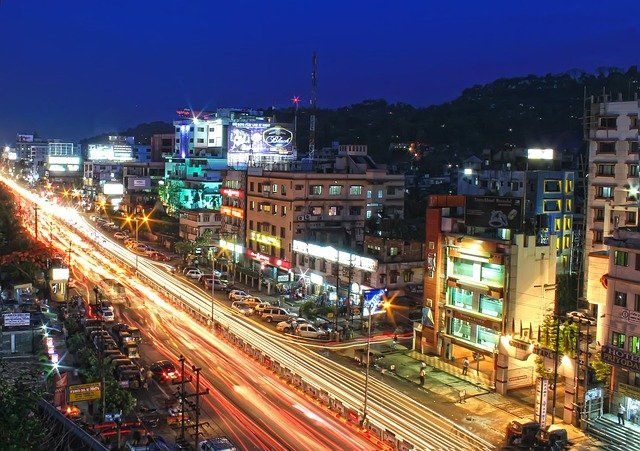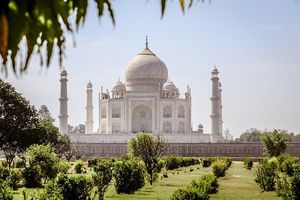History
Civilizations were known in the Indus valley from the earliest times. In A.D. 700 Buddhism was driven out of India by Hinduism and in A.D. 712 Arab invasions of the Indus valley began. There has been perennial conflict between Hindus and Muslims ever since. By the eighteenth century India consisted of 562 princely states ruled by Indian princes or Maharajas.
In 1505 the first European (Portuguese) trading contacts were established. In 1600 Britain formed the East India Company and from the mid-eighteenth to the mid-nineteenth centuries Great Britain progressively subjugated and annexed the various states of India. In 1857 anti-British feeling led to the Indian Mutiny. This was suppressed and Britain reverted to direct rule, leading to the era of the British Raj.
Fifty years ago, in 1947, India gained its independence and was partitioned into India (predominantly Hindu), East Pakistan (mainly Hindu – now Bangladesh) and West Pakistan (mainly Muslim – now Pakistan). Throughout India’s existence internal conflict has often flared, fuelled by religious and ethnic tensions.
Church history
There was a Nestorian church in Kerala from the earliest days. Whether or not the apostle Thomas really did plant the Mar Thoma church is uncertain, but it was reported to be completely heterodox in the fifteenth century. Jesuits came to India in the sixteenth century. Yet it was only the arrival at Tranquebar, in 1706, of Lutheran missionaries from Denmark which gave India the Bible. By 1714 the New Testament had been translated into Tamil.

At a time when political power in India was shifting to the British, news of the Danish mission excited Anglican interest, including that of Henry Martyn. He joined the East India Company as a chaplain and later translated the New Testament into Urdu.
William Carey and John Thomas of the Baptist Missionary Society arrived in Calcutta in 1793. Carey, Joshua Marshman and William Ward later moved to Serampore in 1799. By Carey’s death in 1834 the Bible had been translated into Bengali, Oriya, Assamese, Sanskrit, Hindi and Marathi. Other Protestant missionaries soon arrived in India, including Alexander Duff in 1830, who tried to break into Hinduism by teaching Christian truth through higher education. Although he saw some notable conversions, this approach did not succeed in winning over the higher castes.
During the twentieth century India has been at the forefront of ecumenism. The Churches of South India (1947) and North India (1970) were formed through the union of several denominations. The Church of South India has been a ‘flagship’ of the ecumenical movement. Worldwide ecumenism has led many to substitute the true gospel with a social gospel and to minimize the uniqueness of Christ. This has opened the door to religious pluralism and India has not been immune to any of these influences.
In 1947 the new constitution of India guaranteed religious freedom to the churches. This meant that some states opened up to Christian missionaries for the first time. Yet by the late 1960s the situation was in retreat; Orissa and Madhya Pradesh passed laws designed to make conversions from Hinduism to other religions more difficult and there were widespread anti-Western attitudes throughout India. Government restrictions on visas led to a sharp decrease in the size of the ex-patriate missionary force. This situation still remains.

Current situation
The Indian evangelical churches have, therefore, had to become self-supporting and self-propagating by force of circumstance, although much of the church has been without adequate pastoral leadership and not properly grounded in the doctrines of the gospel. In spite of this, many churches have shown evangelistic zeal and have particularly tried to reach the under-privileged classes.
While there has been continuing resistance in the Hindu heartlands of the central north there has also been openness to the truth in the south. The north-east too has seen a large influx of people into the churches. For example, one northeastern church has 25,000 adherents, sixty pastors and has sent out eighty missionaries to other parts of India. This group is receiving Reformed literature.
Several large indigenous Indian missions work across India. It is reported that recent evangelistic initiatives have been taken in Kerala, Tamil Nadu, north-east India, Andhra Pradesh and Orissa. A considerable part of this activity has been Arminian in doctrine and practice.
There are areas which are open to the doctrines of grace. One correspondent to Evangelical Times from Tamil Nadu reports that ‘In our areas there are mainly small village congregations with maybe 2,500 to 3,000 believers altogether. At present we have seventy-seven churches. A wide range of people receive [Reformed literature] and write appreciatively. There are some Baptist and a few Presbyterian churches who teach Reformed doctrines.’
Another correspondent who recently visited Andhra Pradesh has reported that some workers there ‘are solidly Reformed and preach the gospel of God’s sovereign grace. This particular ministry is growing rapidly and has planted 300 churches in the province of Andhra Pradesh. The pastors and people have a deep love and hunger for the Word of God. They have been very open and receptive to the doctrines of grace. Also the prayer lives of these people are quite amazing. It is not unusual to have prayer meetings sometimes lasting for five or six hours.’

Large-scale conversions amongst scheduled tribes, that is ‘mass people movements’ into the churches, have taken place during the course of the twentieth century. This has been so in the states of Assam, Meghalaya, Manipur, Mizoram and Nagaland near the Burmese border. Evangelical Times enquiries suggest that these movements need to be carefully evaluated. All important decisions within animist tribes are communally taken, including religious decisions. Yet true conversion can never take place at a communal level – each person must be born again individually and each person must repent and believe in Christ. Even in revival there is a sovereign operation of the Holy Spirit upon individuals. It should be noted too that there may be points of cultural correspondence between tribal beliefs and Christianity which make some more open to listen to the gospel. For example, some northeastern tribes have a great respect for self-sacrifice on behalf of a friend. They would therefore naturally admire the actions of Jesus. However, group decisions based on admiration of Jesus alone are not true conversion. The historical background suggests that some of the early tribal converts experienced true conversion under a powerful influence of the Holy Spirit. More probably many others were wrongly baptized after group decisions to join the church. Some of the latter, in God’s grace, have later been converted, since one obvious result of their decision to move from animism to Christianity is that they have been brought under regular gospel influences. That there is a legacy of reported shallowness, liberalism and nominalism in these Christianized areas is best explained in radical terms such as these outlined.
Challenges
1. Many of India’s 900 million have never heard the Gospel especially in the north. Higher castes too have still to be reached with the gospel.
2. A sizeable proportion of the professing Christian community is nominal. Roman Catholicism in its mariolatry shows syncretistic tendencies with Hinduism.
3. Many evangelicals have been influenced by arminianism, the charismatic movement and ‘power-evangelism’. There has been an uncontrolled proliferation of para-church organizations.
4. Society in India is corrupt. Western money has too often been used to influence church decisions. Misuse of funds and lawsuits over land and property have directly affected some of the churches.
5. There is much poverty and disease in India, with many millions of scheduled peoples who are denied even limited access to government and professional jobs once they have converted to Christianity or Islam. Many professing Christians are reported to have compromised for the sake of material advantage.
6. Single converts from Hindu or Muslim families often face severe persecution. They may well have to leave home and family and in some cases their life is put at risk.
Conclusion
There are spiritual encouragements and bright spots in the churches, but overall India is a land of great spiritual darkness. This is truly an opportune time for God’s people to pray for India and, where possible, take the gospel of sovereign grace to that needy land!










